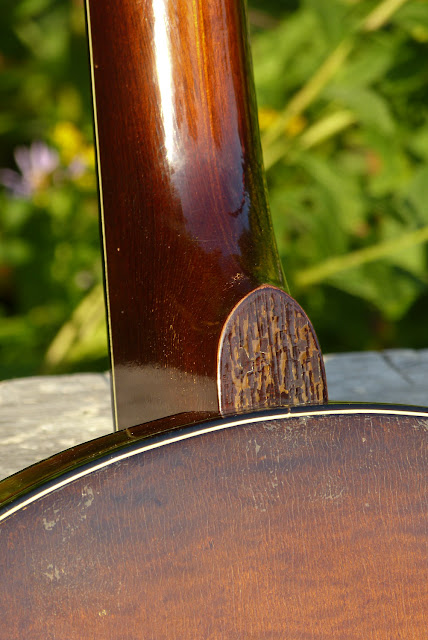1930s Kay-made Kay Kraft Resonator Plectrum Banjo
A fellow and I did a long-distance "Kay for Kay" trade and this is what I got out of it -- a full-on Kay Kraft plectrum banjo. I see Kay Kraft tenors from time to time, but it's not often that I see a plectrum of any type from this late in the game (1930s). Being a Kay, I expected it to have a bit of funk in the build, but I didn't expect it to have such nice trim! This has a two-piece mahogany neck, thick ply-maple rim, and lots of black/white/black celluloid binding that gives it an upscale presence.
Work included a fret level/dress, a new 11" Elite Renaissance-style head, new bridge, and general setup. I have it strung DGBE using 5-string banjo "10s" minus the 5th string. The "Kay funkiness" comes along for the ride in the way the neck has a light backbow in frets 1-4 and then frets 12 and up. This means that it plays "about right" in frets 1-10 and then starts feeling a little stiff from 12 and above. Because of the backbow I can't adjust the action down to perfect 1/16" at the 12th fret because there'd be a ton of buzz in the 1-4 section. It's thus at a respectable 3/32" and for my use (chord-banging) that's "good enough for government work." It's also got a longish 27 1/4" scale length.
Kay Kraft instruments always look great, don't they?
While it looks ebony, the fretboard is actually stained maple.
You can see a bit of overtone-muting foam behind the Elite logo.
The resonator uses flamed maple veneer and one of those cool, gold-look decals borrowed from the guitar lineup.
Original Page patent geared pegs make tuning much easier than the standard-issue friction pegs.
The white/black/white celluloid binding looks pretty handsome on the resonator and fretboard edges. Note also the original side dots!
This rim has a simple hoop tonering on the top of the rim and a simple sleeve "tonering helper" on the side of the rim.
This has Kay's usual variation on the coordinator rod idea.
While the neck has an integrated angle-adjustment gizmo (see next picture), I like to set the angle and then drill and install a "set screw bolt" as well. The reason for that is that Kay's neck adjuster -- no matter how hard you set it with the giant hex bolt on the coordinator rod -- always yields a slightly-wiggly neck. I can't stand that, so I like to lock it in.
Check out the heavy cast flange! It gives the rim some definite heft.






















Comments
I love your work man!